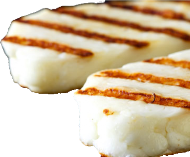Halloumi History
About Us
History
A fabulous Halloumi originate from Cyprus and a favorite in Cypriot cooking. It's an ideal frying cheese because it doesn't melt. A good source of protein is a good sabsutude for meat and complements a healthy vegetarian diet.
HISTORY AND ORIGINS
Although a recent phenomenon for many, hallourni isn't new - it been around for centuries. The name is derived from the medieval Egyptian Arabic holom and in Turkish Side of Cyprus it's still known as hellim. It originated over 1,000 years ago in Cyprus where it was a vatuable source of protein for poor agrarian communities living off the land. Each village had its own special recipe and this semi-hard, unripened white cheese was made communally from sheep's milk. As time passed, goat's milk was sometimes added too, and some modern versions are even made with cow's milk, although purists frown on this practice.
Mint was usually added for flavour, and the cheese keeps better when it is wrapped in fresh mint leaves. The hallourni most of us buy tends to be younger and milder than the dry, salty unpasteurised varieties that are still eaten in Cyprus where it is aged in brine for much longer to intensify the taste.
NUTRITION
Halloumi is rich in protein, vitamin A and calcium. Although, like other cheeses, it is relatively high in fat you can buy reduced-fat versions with 40 per cent less fat. And because most halloumi is made with goat's or-sheep's milk it's much lower in lactose than cow's milk cheeses and can often be tolerated by people with mild lactose intolerance. It is higher in salt than most cheeses (330 mg sodium per 25 g/1oz), so if you're on a low-sodium diet for health reasons, it would be wise to limit your consumption and to eat it in smaller quantities,




